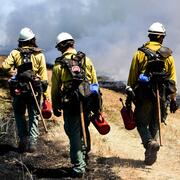Sagebrush and Sage Grouse
New Report Offers Path Forward for Interagency Efforts to Revive the West’s Disappearing Sagebrush Ecosystem
USGS has been a leader in sagebrush ecosystem research and continues to meet the priority science needs of management agencies. We bring a diversity of expertise and capabilities to address a wide variety of science needs at multiple spatial scales and are committed to providing high quality science to our management partners.















